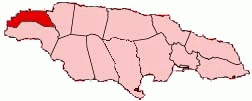
Population: 67,000
Capital: Lucea
Major Towns: Green Island, Sandy Bay, Hopewell

Hanover is Jamaica’s third-smallest parish, located on the island’s northwestern tip and spanning approximately 450 square kilometers (174 square miles). Six rivers traverse this scenic region, with two flowing into the horseshoe-shaped Lucea Harbour - renowned as one of Jamaica’s safest. Surrounded by rolling hills on three sides, the parish boasts the Dolphin Mountain range, crowned by Dolphin Head at 1,789 feet, while its highest point is Birchs Hill at 1,809 feet. Historically, Fort Charlotte could accommodate up to 300 ships at a time, as reported by 18th-century historian Edward Long.
Hanover’s natural attractions include three small waterfalls, multiple coastal coves, and extensive cave systems, offering ample opportunities for exploration. After heavy rainfall, a temporary lake often appears in Chigwell at the parish’s interior, further enhancing the area’s unique landscape.
The earliest known mention of the area dates back to 1515, when King Ferdinand of Spain praised the local Spanish governor for relocating settlers here after Sevilla la Nueva was abandoned. Officially established as Hanover Parish on November 12, 1723, the region was named in tribute to the British royal House of Hanover. In the colonial era, the coastal coves became havens for pirates - most notably Henry Morgan, who would later serve as Lieutenant Governor and acquire 4,000 acres in the parish.
Lucea, the parish capital, once overshadowed Montego Bay in prominence. By the mid-18th century, it had evolved into a bustling sugar port and market hub. European Jews found a home here, establishing themselves as merchants and tradesmen. Post-emancipation, Hanover’s free peasants thrived, supplying much of Jamaica with produce. Several 19th-century structures remain, reflecting the region’s rich architectural heritage. The Hanover Parish Church, originally constructed by the Spaniards, is the only one in Jamaica known to have possessed a steeple; it was damaged in a 1957 earthquake.
Scottish Presbyterian missionaries are believed to have arrived first in Lucea, contributing to a strong Presbyterian presence - now the United Church of Jamaica and Grand Cayman. The Lucea yam was once exported in large quantities to Jamaican laborers in Cuba and Panama. While the harbor, formerly used for banana exports, closed in 1983, the old Fort Charlotte still stands guard at its entrance.
Bloody Bay in nearby Negril reputedly gained its name from historical whaling activities, and it also served as a rendezvous for Europe-bound ships and naval vessels. Hanover is notable as the birthplace of Sir Alexander Bustamante - Jamaica’s first prime minister and a National Hero—born in Blenheim. Scholar Walter Jekyll, famous for compiling “Jamaica Song and Story,” also hailed from the parish.
Modern-day Lucea has seen an economic and cultural revival, buoyed by returning migrants who merge contemporary development with the town’s historical character. Although infrastructure upgrades remain a work in progress, tourism has emerged as a crucial component of Hanover’s future.
Agriculture: Key crops include yams, sugar cane, pimento, turmeric, and breadfruit.
Livestock Rearing: Areas like Shettlewood, Knockalva, Ramble, Haddo, and Saddlers Hall focus on cattle, pig, and goat farming.
Tourism: Hanover hosts notable resorts and attractions, including Round Hill, Tryall (with its acclaimed golf course), and various Negril-area hotels such as Grand Lido, Couples, Sandals, Negril Cabins, and Beaches.
Whether explored for its natural beauty, rich heritage, or promising tourism sector, Hanover remains a vibrant parish offering a memorable slice of Jamaican culture.